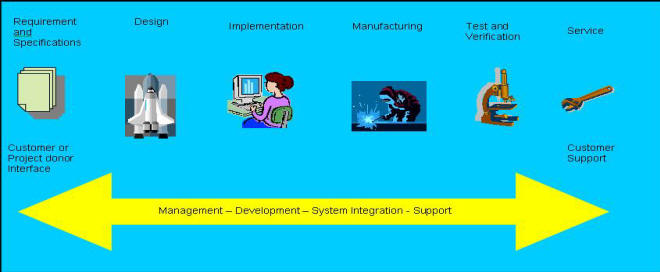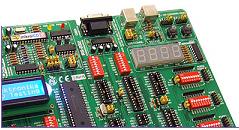PROJECT MANAGEMENT
Galtotronic™ will make you to answer YES to the following questions:
DOES USING THE PRODUCT MAKE USER HAPPY? DO THEY FEEL GOOD ABOUT THEMSELVES BECAUSE THEY OWN AND USE IT?
Galtotronic™
is available to evaluate and elaborate the ideas and suggestions of its
clientele and eventually to industrialise the products created from them
with the aim of being able to offer increasingly better performing and
exclusive devices.
We invite our clients to contact our Research and Development
Laboratory. This is an invitation to develop and industrialise products
from the ideas or from a vision.
PROBLEMS WITH TRADITIONAL DEVELOPMENT AND PROJECT MANAGEMENT
Traditionally, companies are structured in departments. Each department
covers different aspect of the product. Very often, there is poor
communication between departments and the concept of cross functional
team work just remains on the text book.
Occasionally, there is even competition between departments. The outcome
of such situations is that each department runs their own business and
loosing the company’s targets and interests.
The following picture shows a typical model of the traditional
development structure.

From experience, there could be a situation
where part of a company is not aware of the activities done by the rest
of the company. Also, it is not easy and common to find engineers with
experience on different fields and with interface skills towards
different aspect of Engineering.
The results of such status quo are virtual walls and cultural barriers
between departments and different operational sectors of the company.
This could propose challenges to the success of the company business. If
customers feels such environment could walk away for ever.
ADVANTAGES WITH GALTOTRONIC™’s
SERVICE
Galtotronic™'s experience
specializes in Automation, Control Systems and Computer science for the
different industries like: Factory Automation, Robotics, CNC Machinery,
Embedded Systems and Modern
Lifestyle.
Galtotronic™'s experience
goes from Electrical design and drafting, to Hardware Development and
Design, to Electrical Engineering, to Embedded Systems development, to
Software Engineering and Development, to Project Management, to
Prototype building to Lab work, to Service and Customer Support.
Galtotronic™ enjoys any
aspect of the development process, from the requirements capture to the
design to the manufacturing of the prototype with hands on. The
following picture shows the Galtotronic™’s
development structure and project management. Galtotronic™’s
service could offer you such an approach.

PRODUCT DEVELOPMENT PROCESS
The following general model of a product development process will vary in detail between projects and products. The process is both cyclic and linear. Any implementation of it needs a balance between continuous iteration and simply getting the job done.

PROJECT MANAGEMENT MODEL
Galtotronic™'s Project
Management model is the V-model. The V-model is a software
development process which can be presumed to be the extension of the
waterfall model. Instead of moving down in a linear way, the process
steps are bent upwards after the coding phase, to form the typical V
shape. The V-Model demonstrates the relationships between each phase of
the development life cycle and its associated phase of testing.
The V-model deploys a well-structured method in which each phase can be
implemented by the detailed documentation of the previous phase. Testing
activities like test designing start at the beginning of the project
well before coding and therefore saves a huge amount of the project
time.

Verification Phase
Requirements analysis
In the Requirements analysis phase, the requirements of the proposed
system are collected by analysing the needs of the user(s). This phase
is concerned about establishing what the ideal system has to perform.
However it does not determine how the software will be designed or
built. Usually, the users are interviewed and a document called the user
requirements document is generated.
The user requirements document will typically describe the system’s
functional, physical, interface, performance, data, security
requirements etc as expected by the user. It is one which the business
analysts use to communicate their understanding of the system back to
the users. The users carefully review this document as this document
would serve as the guideline for the system designers in the system
design phase. The user acceptance tests are designed in this phase. See
also Functional requirements, and Non-functional requirements
System Design
Systems design is the phase where system engineers analyse and
understand the business of the proposed system by studying the user
requirements document. They figure out possibilities and techniques by
which the user requirements can be implemented. If any of the
requirements are not feasible, the user is informed of the issue. A
resolution is found and the user requirement document is edited
accordingly.
The software specification document which serves as a blueprint for the
development phase is generated. This document contains the general
system organization, menu structures, data structures etc. It may also
hold example business scenarios, sample windows, reports for the better
understanding. Other technical documentation like entity diagrams, data
dictionary will also be produced in this phase. The documents for system
testing is prepared in this phase.
Architecture Design
The phase of the design of computer architecture and software
architecture can also be referred to as high-level design. The baseline
in selecting the architecture is that it should realize all which
typically consists of the list of modules, brief functionality of each
module, their interface relationships, dependencies, database tables,
architecture diagrams, technology details etc. The integration testing
design is carried out in this phase.
Module Design
The module design phase can also be referred to as low-level design. The
designed system is broken up in to smaller units or modules and each of
them is explained so that the programmer can start coding directly. The
low level design document or program specifications will contain a
detailed functional logic of the module, in pseudocode - database
tables, with all elements, including their type and size - all interface
details with complete API references- all dependency issues- error
message listings- complete input and outputs for a module. The unit test
design is developed in this stage.
Validation Phases
Unit Testing
In the V-model of software development, unit testing implies the first
stage of dynamic testing process. According to software development
expert Barry Boehm, a fault discovered and corrected in the unit testing
phase is more than a hundred times cheaper than if it is done after
delivery to the customer.
It involves analysis of the written code with the intention of
eliminating errors. It also verifies that the codes are efficient and
adheres to the adopted coding standards. Testing is usually white box.
It is done using the Unit test design prepared during the module design
phase. This may be carried out by software testers, software developers
or both.
Integration Testing
In integration testing the separate modules will be tested together to
expose faults in the interfaces and in the interaction between
integrated components. Testing is usually black box as the code is not
directly checked for errors. It is done using the integration test
design prepared during the architecture design phase. Integration
testing is generally conducted by software testers.
System Testing
System testing will compare the system specifications against the actual
system. The system test design is derived from the system design
documents and is used in this phase. Sometimes system testing is
automated using testing tools. Once all the modules are integrated
several errors may arise. Testing done at this stage is called system
testing.
Galtotronic™ is
willing to undertake the opportunity to offer its cross functional
experience to successful companies like yours. Please contact us today to discuss further your
project management needs. We would like to hear from you.

